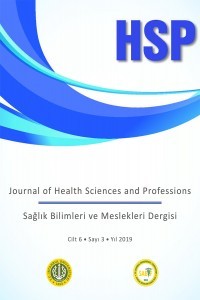Hemşirelere Verilen Kardiyopulmoner Resusitasyon Eğitiminin Bilgi Düzeyine Etkisi
Amaç: Bu çalışma, hemşirelerin kardiyopulmoner resusitasyon (KPR) ile ilgili bilgi düzeylerinin saptanması ve verilen eğitimin KPR ile ilgili bilgi düzeylerine etkisini incelemek amacıyla ön test son test desenli, tek gruplu olarak yapılmıştır. Gereç ve Yöntem: Araştırma Haziran-Ağustos 2012 tarihleri arasında bir devlet hastanesinde dahili, cerrahi, acil ve yoğun bakım ünitelerinde çalışan toplam 108 hemşire ile yürütülmüştür. Veriler anket formu ile toplanmıştır. CPR ile ilgili eğitim (görsel sunu, eğitim broşürü ve maket üzerinde uygulamalı eğitim) üç aşamalı olarak verilmiştir. Verilen eğitimin etkinliği altı hafta sonra anket formu ile tekrar değerlendirilmiştir. Verilerin değerlendirilmesinde yüzdelik dağılımlar, t testi, Mann-Whitney U testi, Kruskal-Wallis testi, Ki-kare analizi, Wilcoxon testi kullanılmıştır. Bulgular: Araştırmada, hemşirelerin %32’sinin daha önce KPR uyguladığı, %39.8’inin KPR ile ilgili hizmet içi eğitime katıldığı, %35.2’sinin hizmet içi eğitim yapılmadığında hekimlerden CPR ile ilgili bilgi aldığı saptanmıştır. Yaş, cinsiyet, öğrenim durumunun hemşirelerin KPR’a ilişkin doğru yanıt ortalamalarında anlamlı bir etkisinin olmadığı tespit edilmiştir. Dahili, cerrahi ve acil serviste çalışan hemşirelerin eğitim öncesi ve eğitim sonrası KPR’a ilişkin doğru yanıt ortalamaları arasındaki fark istatistiksel olarak anlamlı bulunmuş (p<0.05), yoğun bakımlarda çalışan hemşirelerin KPR’a ilişkin doğru yanıt ortalamaları ise istatistiksel olarak anlamsız bulunmuştur (p>0.05). Eğitim tamamlandıktan sonra yapılan değerlendirmede, KPR uygulamasında göğüs bası hızı ve derinliği, yetişkinde temel yaşam desteği sıralaması (C-A-B), ventilasyon, nabız değerlendirme süresi ile ilgili cevaplarda istatistiksel olarak anlamlı artış saptanmıştır. Sonuç: Araştırma sonucunda KPR ile ilgili verilen eğitim sonrasında hemşirelerin doğru yanıt ortalamalarının yükseldiği saptanmıştır. Bu sonuçlar, hemşirelerin KPR konusundaki bilgi ve becerilerinin hizmet içi eğitim programları ile güncellenmesi ve hizmet içi eğitimlerin periyodik olarak tekrarlanması gerektiğini göstermektedir.
Aim: This study was carried out so as to determine nurses’ knowledge level about CPR and to analyse the effect of the given training on the knowledge level about CPR through pre- and after- patterned tests employed on the same group. Material and Methods: The study was conducted between June and August in 2012 with 108 nurses working in the internal, surgery, emergency and intensive care units at a State Hospital. The data was collected by the questionnaire form. The training course about CPR was given within three-stage (visual presentation, training brochure, applied training on models). The effect of the education was re-evaluated after six weeks via questionnaire. Percentage distributions, T-Test, Mann-Whitney U Test, Kruskal-Wallis Test, Ki-Kare Analysis and Wilcoxon Test were used for evaluating the data. Results: It was determined in the study that 32 % of the nurses applied CPR before, 39.8 % participated in in-service training and 35.2 % took the information from doctors when in-service training hadn’t given to them. It was also found that age, sex, marital status and education status had no significant effect on nurses’ correct answer average relating to CPR. The difference (p<0.05) in the correct answer average of the nurses working in interior, surgery and emergency units before and after the training was found very important and the questionnaire results (p>0.05) in the correct answer average of the nurses working in intensive care unit before and after the training were found considerably insignificant. A statistically significant increase was found in terms of the chest compression speed and depth, basic life support ranking (C-A-B), ventilation, and pulse evaluation duration after the training was completed. Conclusions: As a result of the study, the correct answer average of the nurses about CPR was found to be high after training. These findings show that nurses’ knowledge together with their abilities on CPR should be updated via in-service training programs and these programs should be repeated periodically.
___
- Xanthos T, Akrivopoulou A, Pantazopoulos I, Aroni F, Datsis A, Iacovidou N. Evaluation of nurses’ theoretical knowledge in basic life support: A study in a district Greek hospital. International Emergency Nursing. 2012; 20: 28– 32.
- Keenan M, Lamacraft G, Joubert G. A survey of nurses’ basic life support knowledge and training at a tertiary hospital”. African Journal of Health Professions Education. 2009;1: 3-7
